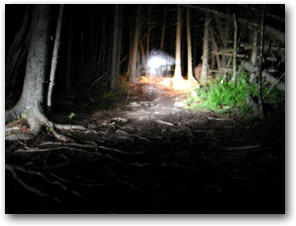
|
|
|
It’s just past midnight. I am standing by the side of a trail deep in the forest, my flashlight aimed at an enormous toad bigger than my fist. The toad, sitting motionless on the ground, stares back at me. Not sure what to make of me, the toad decides to remain cautiously still.
Behind me, a soft sound begins to grow louder and a headlight punctures its way through the darkness. As the small beam of light grows larger, I can see the ground in front illuminating and I can hear the sound of gears changing and, eventually, the sound of a weary rider’s heavy breathing.
I step to the side, and a mountain biker flies past me, tires rumbling as they roll across rocks and bits of exposed tree roots.
Deciding this is too much drama for what would normally be a dark, quiet evening, the toad disappears into the woods with a few quick hops. As the mountain biker retreats into the distance, a deafening silence settles back over the forest and I am once again standing alone, miles away from civilization.
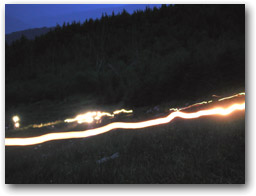
|
|
|
I’m hanging out at West Virginia’s Snowshoe Mountain Resort for the 24 Hours of Snowshoe mountain bike race, and I’ve decided that the best way to understand the race is to hike my way along the course in the dead of night, sharing the experience firsthand with racers.
Along the way, my respect for the racers grows with each step. In addition to the sheer physical challenge of the 24 hour race, participants must endure mud and slippery sections, possible equipment failures, and lack of sleep. Many believe the race is more challenging to the mind than the body, but as I hiked along the course, I decided both the mind and body are equally stressed on this race.
West Virginia-based Granny Gear Productions sponsors the 24 Hours of Snowshoe race, along with 24 Hours of Moab and 24 Hours of Tahoe, which will be held later this year. As the name suggests, the race takes 24 hours - starting at noon on Saturday and ending at noon the following day.
Laird Knight, President of Granny Gear Productions, kicked off festivities on Saturday morning, June 29, describing rules of the race. Nursing an injured and casted knee from a biking mishap a few days earlier (it “bent in a way knees aren’t designed to bend,” he explained to me), his enthusiasm for the event was clear as he thanked racers for participating.
The race includes different categories and prizes totaling $100,000. 5 Coed Pro/Am teams are favored to win the race, while 17 solo men and 2 solo women tackle the 24 hour race in a non-relay format. Other categories include men and women’s expert, men and women’s sport, and men and women’s veteran. Most racers participate in teams and try to log as many laps within the 24 hour periods, alternating riders for each lap in the 11-mile course.
In its 11th year, the race has gone hi-tech: racers carry a radio frequency ID card and log in electronically as they begin their lap. RealTime(tm) scoring, which debuted at last year’s race, automatically inserts racer times into a database and provides a real-time display of team standings. Throughout the race, times appeared automatically on Granny Gear’s web site, integrated with racer and team information.
Although scoring is hi-tech, the course is decidedly low-tech, providing a selection of Mother Nature’s barest essentials: dirt, mud, rocks, tree roots, and plenty of elevation change.
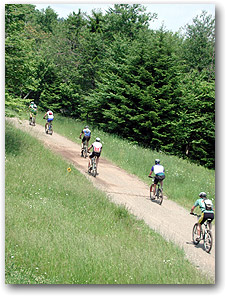
|
|
|
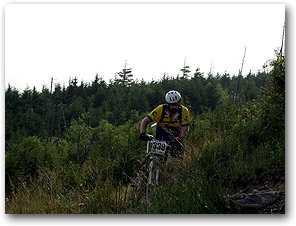
|
|
|
Next stop is Highwall, twisty singletrack that climbs above treeline before cresting with a beautiful view of the valleys below. Highwall presents a nice climax for the course, but few racers have the endurance to ride up the steep singletrack.
It’s mostly downhill from here, with Bobcat Alley, a twisting descent through the forest, and Home Run, with some very steep, twisty, and slippery sections racers must negotiate before finally blasting through to the Silver Creek base area. After logging out of the course, most racers have a chance to relax while other team members take on the next lap, but for solo riders, the end of one lap means the start of another.
Although the drama takes place on the course, plenty of emotion is evident in the campgrounds, where racers rest between laps and support crews prepare bikes for their next run.
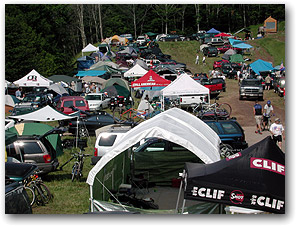
|
|
|
Campsites are found throughout the Silver Creek base area, ranging from the simple - a sleeping bag on the ground - to the elaborate - full-blown RV’s with all the accouterments.
At night, team members and supporters could be seen crowded around campfires, smoke wisping into the air as the sounds of guitars and drums echoed throughout the campgrounds. Many teams used handheld radios to keep in touch with teammates (cell phones don’t work in this part of West Virginia), so the staticy crackle of a racer checking in could frequently be heard throughout the base area.
Spectators were kept busy with a Vendor Expo, Dangerous Dan’s Flow Show, a Bluegrass Jamboree and more. Children were given an opportunity to participate in a race of their own: the 24 Minutes of Snowshoe race.
It’s now well past midnight and I am beginning to have second thoughts about my decision to hike the course. Miles deep into the course, I am hiking through thick mud, my feet sliding and sinking with each step - risking a sprained ankle from one careless step.
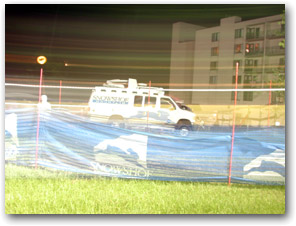
|
|
|
Yet, I am having a great time. The temperature is perfect - in the 60’s - and I’m able to appreciate the beauty of the forest at night - catching a glimpse of nocturnal animals such as the surprised toad and deer who aren’t used to seeing mountain bikers in the forest at night.
At any given time, hundreds of bikers are spread along the 11-mile course. I am never alone for more than a minute or two before a racer passes by. Racers are friendly - offering “hellos” to me as they pass, or asking questions (sorry, I don’t have any beer!) More than one are surprised that I would be hiking at 1:30 a.m. on the course on my own free will.
Closer to 2 a.m., racers begin to be less talkative and seem to be struggling just to stay awake, worn down by the course and the revelation that there are still 10 hours left in the race - and many laps to go.
I finally reach the Silver Creek base area and decide to call it a night - my legs and feet so sore I can barely stand. Spectators cheer me on as I arrive, jokingly asking me if I lost my bike.
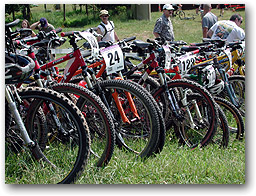
|
|
|
As the sun rises the next morning (an event I slept through), teams continued their race, logging laps that grew successively more challenging. At noon, teams began to complete their race. (Standings were based on how many laps were completed, and how quickly; if two teams both completed 14 laps but the finished the last lap at 12:10 p.m. and 12:30 p.m., respectively, the first team would place higher.) Final standings are posted here.
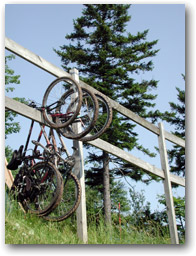
|
|
|
Jeremiah Bishop, a member of the powerhouse Trek/VW/JBL East Coast team (which placed first in the Coed Pro/Am class with 18 laps in 12 hours, 27 minutes), claimed the quickest time for a single lap: just under 1 hour and 4 minutes.
After the race and closing festivities, the campgrounds began to clear out and weary participants headed home - some as far away as California or even Canada. With them, they took a weekend full of memories that will last a lifetime.
For some, the end of the race represents the end of a personal challenge - a desire to finish the race, even if that means finishing last.
For others, the 2002 24 Hours of Snowshoe race is simply a stopping point on the way to other races. Some racers plan to attend the 24 Hours of Tahoe race in California (August 24-25, 2002), and the 24 Hours of Moab race in Utah (October 12-13, 2002).
All photos by M. Scott Smith.
M. Scott Smith is the founder and Editor of DCSki. Scott loves outdoor activities such as camping, hiking, kayaking, skiing, and mountain biking. He is an avid photographer and writer.